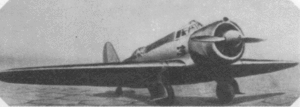| KhAI-5 / R-10 / PS-5 | |
|---|---|
| Role | Reconnaissance and light bomber monoplane |
| National origin | Soviet Union |
| Manufacturer | Kharkiv Aviation Institute |
| Designer | Iosif Grigorevich Nyeman |
| First flight | June 1936 |
| Primary user | Soviet Air Force |
| Number built | 500+ |
The Kharkov R-10 (KhAI-5) was a Soviet reconnaissance and light bomber aircraft, designed in the mid-1930s in the Kharkiv Aviation Institute (KhAI, HAI - in Russian: ХАИ), under the direction of Iosif Grigorevich Nyeman.
Development[]
The first prototype of the plane, with a factory designation KhAI-5 (ХАИ-5), flew in June 1936. Despite a lower performance, the aircraft won a contest against another reconnaissance plane design, the Kotcherigin R-9, and was accepted for a production with the military designation R-10 ('R' meant a purpose - razvyedchik - reconnaissance). It was quite a modern design at that time. 493 R-10s had been manufactured in Kharkiv and Saratov aviation plants by early 1940. The first series showed some teething problems, and because of these I. Neman was arrested by the NKVD on December 11, 1938 under false accusation of sabotage and espionage.
In 1938, a variant KhAI-5bis was tested - fitted with an M-25E engine, it developed a speed of 425 km/h (264 mph). In 1938, the KhAI-52 ground attack aircraft, based on the R-10, was also developed. It was fitted with an M-63 670 kW (900 hp) engine and armed with seven machine guns and 400 kg (882 lb) bombs. A production run of an experimental series of 10 aircraft was prepared, but it was cancelled after I. Neman had been arrested.
Some production R-10s were fitted with more powerful Tumansky M-88, Shvetsov M-62 and M-63 engines. Over 60 aircraft, withdrawn from the Air Force, were used from 1940 as mail carriers by Aeroflot, under the designation PS-5 (Russian: ПС-5), with 3 passenger seats.
Combat use[]
The aircraft entered service in the Soviet Air Force in 1937, replacing some Polikarpov R-5s. R-10s were first used in combat in the Soviet-Japanese Battle of Khalkhin Gol in 1939. Then, they were used in the initial stage of the World War II, starting with use against Poland in the Invasion of Poland (without combat encounters) and against Finland in the Winter War (1939–1940). R-10s were next used in the first period of the German-Soviet war, following the German attack on June 22, 1941. By this time, they were outdated and suffered heavy losses, as did the rest of the Soviet Air Force. Many planes were destroyed on airfields. They were used as close reconnaissance aircraft, and, in need, also as light attack bombers. Later many were used as night bombers, to avoid losses in encounters with fighters. The remaining R-10s were withdrawn from combat service in 1943 (two Finnish pilots claimed shooting R-10 in 1944).
Description[]
The aircraft was conventional in layout, with low, plywood-covered wooden wings. The fuselage was of semi-monocoque construction. The undercarriage retracted into the wings. The crew consisted of two: a pilot and an observer-rear gunner in separate compartments; the observer sat in a turret with one machine gun. In the observer compartment's floor there was an AFA-13 camera for reconnaissance duties. Between the crew compartments there were fuel tanks and a vertical bomb bay. The maximum bomb load was 300 kg/661 lb (6 × 50 kg/110 lb or 10 × 25 kg/55 lb). The plane was powered initially by the M-25A, later M-25V radial engine power: 540 kW (730 hp). The two-blade propeller was made of metal.
Operators[]
- Aeroflot
Variants[]
- R-10 - Production version of KhAI-5
- KhAI-5bis - Improved R-10/KhAI-5 (a.k.a. KhAI-51), one example flown early 1939.
- KhAI-52 - Production version of KhAI-51. Ten ordered but production halted with the arrest of I.Nyeman.
Specifications[]
Data from [1]
General characteristics
- Crew: 2
- Length: 9.3 m (30 ft 6 in)
- Wingspan: 12.2 m (40 ft 0 in)
- Wing area: 26.8 m2 (288 sq ft)
- Empty weight: 1,823 kg (4,019 lb)
- Gross weight: 2,515 kg (5,545 lb)
- Fuel capacity: 260 kg (573 lb) fuel + 30 kg (66 lb) oil
- Powerplant: 1 × Shvetsov M-25 (license-built Wright SGR-1820-F-3 Cyclone) 9-cyl. air-cooled radial piston engine, 531 kW (712 hp)
- Propellers: 2-bladed Hamilton Standard two-pitch propeller
Performance
- Maximum speed: 350 km/h (217 mph; 189 kn) at sea level
- 388 km/h (241 mph) at 2,500 m (8,202 ft)
- Landing speed: 125 km/h (78 mph)
- Range: 1,450 km (901 mi; 783 nmi)
- Service ceiling: 7,700 m (25,262 ft)
- Time to altitude: 1,000 m (3,281 ft) in 2 minutes 24 seconds
- 5,000 m (16,404 ft) in 12 minutes
- Take-off distance: 250 m (820 ft)
- Landing distance: 230 m (755 ft)
Armament
- Guns:
- 2 x fixed forward firing 7.62 mm (0.300 in) ShKAS machine-guns in the forward top decking
- 1 x manually aimed ShKAS machine-gun in the rear turret
- Bombs: 6 x 50 kg (110 lb) FAB 50 bombs in internal bays
See also[]
- Kharkov KhAI-6
- Heinkel He 70
- PZL.23 Karaś
- DAR-10
- Vultee V-11
- Northrop Delta
- List of Interwar military aircraft
- List of aircraft of World War II
- List of military aircraft of the Soviet Union and the CIS
References[]
- ↑ Gunston, Bill (1995). The Osprey Encyclopaedia of Russian Aircraft 1875–1995. London: Osprey. pp. 149. ISBN 1 85532 405 9.
External links[]
- "Неман Р-10 (ХАИ-5)" (in russian). Уголок неба. http://www.airwar.ru. http://www.airwar.ru/enc/spyww2/r10.html. Retrieved 27 February 2011.
| |||||
| |||||||||||||||||||||||
The original article can be found at Kharkov KhAI-5 and the edit history here.
